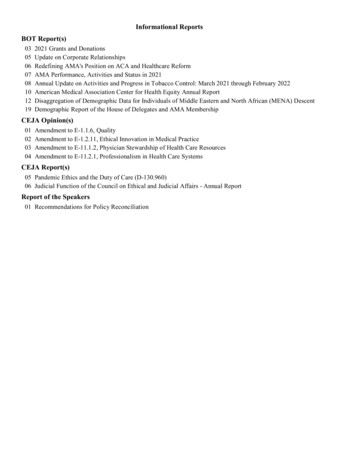
Transcription
Corporate Medical PolicyProstheticsTable of ContentsDescriptionBenefit ApplicationPolicy StatementCoveredNot CoveredPhysician DocumentationPolicy GuidelinesBackgroundRegulatory StatusScientific ReferencesPolicy Implementation and UpdatesRelated MaterialsAuthorization FormBreast Reconstruction Coverage PolicyDescription of Procedure or ServiceProsthetics are artificial devices that replace a missing body part. Some examples include upper andlower limbs, eyes, jaw & face, breasts, ears, hands and feet.Benefit ApplicationThis medical policy relates only to the services or supplies described herein. Please refer to theMember's Benefit Booklet for availability of benefits.Policy StatementGEHA will provide coverage for prosthetics when it is determined to be medically necessary because themedical criteria and guidelines as documented below have been demonstrated.This coverage policy does not pertain to internal prosthetics including but not limited to cardiac valves,joint replacements, teeth and supportive structures of the teeth.If more than one prosthetic device can meet your functional needs, Benefits are available only for theprosthetic device that meets the minimum specifications for your needs. If you purchase a prostheticdevice that exceeds these minimum specifications, the Plan will pay only the amount that the Planwould have paid for the prosthetic that meets the minimum specifications, and you will be responsiblefor paying any difference in cost.
When prosthetic devices are coveredAn initial or replacement prosthetic device is a covered health care service when all of the followingcriteria are met:A. The prosthetic device replaces a limb or a body part, limited to:1. Artificial arms, legs, feet, and hands.2. Artificial face, eyes, ears, and nose.3. Breast prosthesis as required by the Women's Health and Cancer Rights Act of 1998.Refer to the GEHA Breast Reconstruction Coverage PolicyB. The prosthetic device is ordered by or under the direction of a physician; andC. The prosthetic device is Medically Necessary, as defined in the member’s specific benefit plandocument; andD. The prosthetic device is not subject to a coverage exclusion in the member’s specific benefitplan document.For limb prosthetics, the coverage determination must be made in light of the member’s functionalneeds or potential functional abilities, as defined in the member’s specific benefit plan document.Member’s potential functional abilities are based on reasonable expectations of the Prosthetist, andtreating Physician, considering factors including, but not limited to: The member’s past history (including prior prosthetic use if applicable); andThe member’s current condition including the status of the residual limb and the nature of othermedical problems.Computerized Prosthetic LimbsFor the purposes of this policy, the terms computerized, bionic, microprocessor, or myoelectricprostheses are considered thesame.A. Computerized prosthetic limbs are a covered health care service when all of the followingcriteria are met:1. Each of the criteria in the Prosthetic Devices section is met; and2. Member is evaluated for his/her individual needs by a healthcare professional with thequalifications and training to make an evaluation under the supervision of the orderingphysician (documentation should accompany the order); and3. Ordering physician signs the final prosthetic proposal; and4. The records must document the member’s current functional capabilities and his/herexpected functional rehabilitation potential, including an explanation for the difference,if that is the case. (It is recognized within the functional classification hierarchy thatbilateral amputees often cannot be strictly bound by functional level classifications); and5. Prosthetic replaces all or part of a missing limb; and6. Prosthetic will help the member regain or maintain function; and7. Member is willing and able to participate in the training for the use of the prosthetic(especially important in use of a computerized upper limb); andOrigination Date: July 2022Peer Reviewed: July 2022Next Review Date: June 2023
8. Member is able to physically function at a level necessary for a computerized prostheticor microprocessor, e.g., hand, leg, or foot.Lower Limbs (Computerized and/or Specialized)Coverage of computerized and specialized lower limb prostheses is based on maximum prostheticfunction level of the member (see Lower Limb Rehabilitation Classification Levels 1-4).A. Member meets each criterion for computerized prosthetic limb(s); andB. Member has or is able to gain Lower Limb Rehabilitation Classification Levels 2-4 for prostheticambulation.HCPCS Code DescriptionAnklesL5982 Lower limb rehabilitation classification is 2 or aboveL5984 Lower limb rehabilitation classification is 2 or aboveL5985 Lower limb rehabilitation classification is 2 or aboveL5986 Lower limb rehabilitation classification is 2 or aboveHipsL5961 Functional level is 3 or aboveKneesNote: Basic lower extremity prostheses include a single axis, constant friction knee. Otherprosthetic knees are indicated based upon functional classification.K1014 Functional level is 3 or aboveK1022 Functional level is 3 or aboveL5930 Functional level is 4 or aboveL5610 Functional level is 3 or aboveL5613 Functional level is 3 or aboveL5614 Functional level is 3 or aboveL5722 Functional level is 3 or aboveL5724 Functional level is 3 or aboveL5726 Functional level is 3 or aboveL5728 Functional level is 3 or aboveL5780 Functional level is 3 or aboveL5814 Functional level is 3 or aboveL5822 Functional level is 3 or aboveL5824 Functional level is 3 or aboveL5826 Functional level is 3 or aboveL5828 Functional level is 3 or aboveL5830 Functional level is 3 or aboveL5840 Functional level is 3 or aboveL5848 Functional level is 3 or aboveL5856 Functional level is 3 or aboveL5857 Functional level is 3 or aboveOrigination Date: July 2022Peer Reviewed: July 2022Next Review Date: June 2023
L5858 Functional level is 3 or aboveL5859 Meets all of the criteria below:Has a microprocessor (swing and stance phase type (L5856)) controlled (electronic) knee1. K3 functional level only; and2. Weight greater than 110 lbs. and less than 275 lbs.; and3. Has a documented comorbidity of the spine and/or sound limb affecting hip extensionand/or quadriceps function that impairs K-3 level function with the use of a microprocessorcontrolled knee alone; and4. Is able to make use of a product that requires daily charging; and5. Is able to understand and respond to error alerts and alarms indicating problems with thefunction of the unitMicroprocessor or Specialized Foot or FeetNote: A user adjustable heel height feature (L5990) will be denied as not meeting criteria forcoverage.L5972 Functional level is 2 or aboveL5973 Functional level is 3 or aboveL5976 Functional level is 3 or aboveL5978 Functional level is 2 or aboveL5979 Functional level is 3 or aboveL5980 Functional level is 3 or aboveL5981 Functional level is 3 or aboveL5987 Functional level is 3 or aboveSocketsException: A test socket is not indicated for an immediate prosthesis (L5400-L5460).Note: Socket replacements are indicated if there is adequate documentation of functionaland/or physiological need. It is recognized that there are situations where the explanationincludes but is not limited to: Changes in the residual limb;Functional need changes;Or irreparable damage or wear/tear due to excessive member weight or prostheticdemands of very active amputees.L5618 More than 2 test (diagnostic) sockets for an individual prosthesis are not indicated unlessthere is documentation in the medical record which justifies the needL5620 More than 2 test (diagnostic) sockets for an individual prosthesis are not indicated unlessthere is documentation in the medical record which justifies the needL5622 More than 2 test (diagnostic) sockets for an individual prosthesis are not indicated unlessthere is documentation in the medical record which justifies the needL5624 More than 2 test (diagnostic) sockets for an individual prosthesis are not indicated unlessthere is documentation in the medical record which justifies the needOrigination Date: July 2022Peer Reviewed: July 2022Next Review Date: June 2023
L5626 More than 2 test (diagnostic) sockets for an individual prosthesis are not indicated unlessthere is documentation in the medical record which justifies the needL5628 More than 2 test (diagnostic) sockets for an individual prosthesis are not indicated unlessthere is documentation in the medical record which justifies the needL5654 No more than two of the same socket inserts are allowed per individual prosthesis at thesame timeL5655 No more than two of the same socket inserts are allowed per individual prosthesis at thesame timeL5656 No more than two of the same socket inserts are allowed per individual prosthesis at thesame timeL5658 No more than two of the same socket inserts are allowed per individual prosthesis at thesame timeL5661 No more than two of the same socket inserts are allowed per individual prosthesis at thesame timeL5665 No more than two of the same socket inserts are allowed per individual prosthesis at thesame timeL5673 No more than two of the same socket inserts are allowed per individual prosthesis at thesame timeL5679 No more than two of the same socket inserts are allowed per individual prosthesis at thesame timeL5681 No more than two of the same socket inserts are allowed per individual prosthesis at thesame timeL5683 No more than two of the same socket inserts are allowed per individual prosthesis at thesame timeWhen prosthetics for upper limbs are coveredMyoelectric upper limbs (arms, joints, and hands) are eligible for coverage and are Medically Necessarywhen the following criteria are met:A.B.C.D.Member meets all the criteria for computerized prosthetic limbs; andMember has a congenital missing or dysfunctional arm and/or hand; orMember has a traumatic or surgical amputation of the arm (above or below the elbow); andThe remaining musculature of the arm(s) contains the minimum microvolt threshold to allowoperation of a Myoelectric Prosthetic Device (usually 3-5 muscle groups must be activated touse a computerized arm/hand), no external switch; andE. A standard passive or body-powered Prosthetic Device cannot be used or is insufficient to meetthe functional needs of the individual in performing activities of daily living (ADL’s); andF. The medical records must indicate the specific need for the technological or design features.When other prosthetics are coveredEye prosthetics (V2623, V2626, V2627, V2629 & L8610) are eligible for coverage and are medicallynecessary when the following criteria are met:Origination Date: July 2022Peer Reviewed: July 2022Next Review Date: June 2023
A.B.C.D.Absence of an eye from a congenital defect orAbsence of an eye from a disease orAbsence of an eye from an injury orAbsence of an eye from surgical removalGEHA considers the following medically necessary:A. 1 (one) enlargement or reduction of an eye prosthetic (V2625, V2626)B. Polishing and resurfacing (V2624) of a prosthetic eye on a twice-yearly basis.Facial and Ear prosthetics (21077, 21086-21088, L8040-L8048) are eligible for coverage and aremedically necessary when the following criteria are met:A.B.C.D.Absence of facial/ear tissue from a congenital defect orAbsence of facial/ear tissue from a disease orAbsence of facial/ear tissue from an injury orAbsence of facial/ear tissue from surgical removalTesticular prosthetics (54660) are eligible for coverage and are medically necessary when the followingcriteria are met:A.B.C.D.Absence of testes from a congenital defect orAbsence of testes from a disease orAbsence of testes from an injury orAbsence of testes from surgical removalInformation regarding coverage determination/limitations for testicular prosthetics relating to genderreassignment surgery can be found in the GEHA Surgical Treatment of Gender Dysphoria coveragepolicy.Breast prosthesisInformation regarding coverage determination/limitations for breast prosthesis can be found in theGEHA Breast Reconstruction coverage policy. Breast Reconstruction Coverage PolicyWhen prosthetic components are not coveredGEHA considers the following not medically necessary:A. Lower limb prosthetic device for functional level 0B. Additions/components that are not required for the effective use of the deviceC. Consumable supplies for the care of prosthetic device (e.g., cosmetics, creams, cleansers, skinbarrier wipes)D. Prosthetic devices or additions/components not required for participation in normal activities ofdaily living, including those that are chiefly for convenience, for participation in recreationalactivities, or that otherwise exceed the medical needs of the individual (e.g., back-up/duplicateprosthetic devices, waterproof leg prosthesis [e.g., Water Leg, used for showering, swimming])E. Duplication or upgrade of a functional prostheticOrigination Date: July 2022Peer Reviewed: July 2022Next Review Date: June 2023
F. Repair or replacement of a prosthesis for appearance, comfort, convenience or individual abuse,misuse or neglectPolicy GuidelinesLower Limb Rehabilitation Classification Levels: A clinical assessments of member rehabilitationpotential must be based on the following classification levels:K-Level 0: Does not have the ability or potential to ambulate or transfer safely with or withoutassistance and prosthesis does not enhance their quality of life or mobility.K-Level 1: Has the ability or potential to use prosthesis for transfers or ambulation on levelsurfaces at fixed cadence. Typical of the limited and unlimited household ambulator.K-Level 2: Has the ability or potential for ambulation with the ability to traverse low levelenvironmental barriers such as curbs, stairs or uneven surfaces. Typical of the limitedcommunity ambulator.K-Level 3: Has the ability or potential for ambulation with variable cadence. Typical of thecommunity ambulator who has the ability to traverse most environmental barriers and mayhave vocational, therapeutic, or exercise activity that demands prosthetic utilization beyondsimple locomotion.K-Level 4: Has the ability or potential for prosthetic ambulation that exceeds basic ambulationskills, exhibiting high impact, stress, or energy levels. Typical of the prosthetic demands of thechild, active adult, or athlete.Veteran Affairs/Department of Defense Clinical Practice Guideline for rehabilitation of individuals withlower limb amputation supports (weak) offering microprocessor knee units over non-microprocessorknee units for ambulation to reduce risk of falls and maximize patient satisfaction. There is insufficientevidence to recommend for or against any particular socket design, prosthetic foot categories, andsuspensions and interfaces. Microprocessor knees may reduce risk of falls and maximize patientsatisfaction in limited and unlimited community ambulators (Kannenberg, et. al., 2014. & Samuelsson,et. al., 2012).The provider should consider the many characteristics of each type of knee when making a selection: 1.Patient functioning level 2. Availability of processor charging and the functionality of the unchargedprosthesis 3. Patient goals and outcomes using the prosthetic.Physician documentationMedical notes documenting all of the following: Current prescription or order from physicianMember’s weight and heightCo-morbiditiesMedical history related to the prosthetic request:Origination Date: July 2022Peer Reviewed: July 2022Next Review Date: June 2023
o Date and level of amputationo Etiology of absent limbo Condition of residual and contralateral limb, if applicableo Range of motion (ROM), if applicableo Limitations to activities of daily living (ADLs), without the prosthetico Member’s functional needs and functional potential as determined by the treating physicianand prosthetist Environment in which the device will be used, including surfaces normally traversedPrescribing physician notes, therapist notes (if applicable)Prosthetist notesIf the prosthetic is new or a replacementIf it will be a preparatory or definitive deviceDescription of the prosthetic component(s) being requestedo Include medical justification for each component requestedo Quote to include itemized HCPCS codes and quantity requested signed by the prescribingphysiciano Make and model of prosthetic, if applicableFor replacement requests, also include the following: Indicate the components on the current prosthesisAge of the current prosthesis including date initially receivedReason for replacementRepair quote, if applicableDescribe changes in limb including, but not limited to, comparative residual limbmeasurementsIf the request is for a socket replacement, describe what adjustments have been triedand failedFor upper extremity myoelectric prostheses, also include the following: Explanation of why a body-powered prosthesis does not meet functional needs or is contraindicatedMyotesting results to show the remaining musculature of the arm(s) contains the minimummicrovolt threshold to allow operation of a myoelectric prosthetic deviceBackgroundMicroprocessor Controlled ProsthesisThe compensations occurrence due to the alteration of the posture and the gait of persons with lowerlimb amputation is still an issue in prosthetic fitting. Recently, prosthetic feet designed to reproduce theOrigination Date: July 2022Peer Reviewed: July 2022Next Review Date: June 2023
physiological behaviour of the ankle using a microprocessor control have been commercialized toaddress this issue. Objectives: Investigate the relevance of these microprocessor prosthetic ankles(MPAs) in the ability of standing on both level and inclined surfaces. Methods: Six persons withtranstibial amputation usually fitted with energy storing and returning (ESR) foot tested three MPAs:Elan( ) Endolite (MPA1), Meridium( ) Ottobock (MPA2), ProprioFoot( ) Ossur (MPA3). Each MPA dataacquisition was preceded of a 2 weeks adaptation period at home and followed by a 3-weeks wash-outperiod with their ESR. Lower limb angular position and moment, Centre of Pressure (CoP) position,Ground Reaction Forces (GRF) and functional scores were collected in static, on level ground and 12%inclined slope. Results: MPAs allowed a better posture and a reduction of residual knee moment onpositive and/or negative slope compared to ESR. Results also reflect that the MPA2 allows the bestcontrol of the CoP in all situations. Conclusions: An increased ankle mobility is associated with a betterposture and balance on slope. Gait analysis would complete these outcomes. Clinical relevance: Thisstudy compares three MPAs to ESR analysing static posture. Static analysis on level ground and sloperepresents the challenging conditions people with amputation have to cope with in their daily life,especially outdoors. Having a better understanding of the three MPAs behaviour could help toadequately fit the prosthesis to each patient. Implications for rehabilitation This is a study comparingthree MPAs. The static analysis in standard and constraining conditions (slope) reflects the balance ofpeople with amputation in their daily life, especially outdoors. Having a better understanding of thebehaviour of each foot could help to adequately fit the prosthesis to each patient (Thomas-Pohl et al.2019).A study to examine the impact of five common prosthetic ankle-foot mechanisms on functional mobilityin a large sample of individuals with amputation due to diabetes/dysvascular disease was conducted byWurdeman et al. METHODS: A retrospective analysis of the Prosthetic Limb Users' Survey of Mobility(PLUS-M ) captured in the patient care setting. A total of 738 individuals were included andsubsequently subdivided into five groups based on the ankle-foot mechanism of their currentprosthesis. Groups were compared using a general linear univariate model with age, body mass index,comorbid health status, time since amputation, and amputation level entered as covariates. RESULTS:The microprocessor ankle-foot group had the highest mobility (F(4,728) 3.845, p 0.004), which wasfollowed by the vertical loading pylon type ankle-foot, the hydraulic ankle-foot, the flex-walk-type anklefoot, and lastly the flex-foot-type ankle-foot. CONCLUSION: These results demonstrate that the selectionof different prosthetic ankle-foot technology directly impacts functional mobility for the patient with anamputation due to diabetes and/or vascular disease.Myoelectric ProsthesisMyoelectric control refers to the decoding of motor intent from electrophysiological properties ofmuscles for use as a control input for some external interface.A study was conducted to investigate the feasibility of direct, continuous electromyographic (dEMG)control of a powered ankle prosthesis, combined with physical therapist-guided training, for improvedstanding postural control in an individual with transtibial amputation. Specifically, EMG signals of theresidual antagonistic muscles (i.e. lateral gastrocnemius and tibialis anterior) were used toproportionally drive pneumatical artificial muscles to move a prosthetic ankle. Clinical-based activitieswere used in the training and evaluation protocol of the control paradigm. We quantified the EMGsignals in the bilateral shank muscles as well as measures of postural control and stability. Compared toOrigination Date: July 2022Peer Reviewed: July 2022Next Review Date: June 2023
the participant's daily passive prosthesis, the dEMG-controlled ankle, combined with the training,yielded improved clinical balance scores and reduced compensation from intact joints. Cross-correlationcoefficient of bilateral center of pressure excursions, a metric for quantifying standing postural control,increased to .83( .07) when using dEMG ankle control (passive device: .39( .29)). We observedsynchronized activation of homologous muscles, rapid improvement in performance on the first day ofthe training for load transfer tasks, and further improvement in performance across training days (p .006). This case study showed the feasibility of this dEMG control paradigm of a powered prostheticankle to assist postural control (Fleming et al., 2021).Regulatory StatusAccording to the FDA Code of Federal Regulations, external limb prosthetic components are consideredClass I devices and, as such, are exempt from the 510(k) Premarket Notification regulatory process.Scientific ReferencesFleming A, Huang S, Buxton E, Hodges F, Huang HH. Direct continuous electromyographic control of apowered prosthetic ankle for improved postural control after guided physical training: A case study.Wearable Technol. 2021;2:e3. doi: 10.1017/wtc.2021.2. Epub 2021 Apr 12. PMID: 34532707; PMCID:PMC8443146.Kannenberg A, Zacharias B, Probsting E. Benefits of microprocessor-controlled prosthetic knees tolimited community ambulators: Systematic review. J Rehabil Res Dev. 2014;51(10):1469-1496.Samuelsson KA, Toytari O, Salminen AL, Brandt A. Effects of lower limb prosthesis on activity,participation, and quality of life: A systematic review. Prosthet Orthot Int. Jun 2012;36(2):145-158.Thomas-Pohl M, Villa C, Davot J, et al. Microprocessor prosthetic ankles: comparative biomechanicalevaluation of people with transtibial traumatic amputation during standing on level ground and slope.Disability and Rehabilitation Assistive Technology. 2019:1-10.Wurdeman SR, Stevens PM, Campbell JH. Mobility analysis of amputees (MAAT 5): Impact of fivecommon prosthetic ankle-foot categories for individuals with diabetic/dysvascular amputation. Journalof Rehabilitation and Assistive Technologies Engineering. 2019;6:2055668318820784.Policy implementation and updatesJune 2022OriginationCO-WEB-0822-001Origination Date: July 2022Peer Reviewed: July 2022Next Review Date: June 2023
B. Polishing and resurfacing (V2624) of a prosthetic eye on a twice-yearly basis. Facial and Ear . prosthetics (21077, 21086-21088, L8040-L8048) are eligible for coverage and are medically necessary when the following criteria are met: A. Absence of facial/ear tissue from a congenital defect or B. Absence of facial/ear tissue from a disease or











